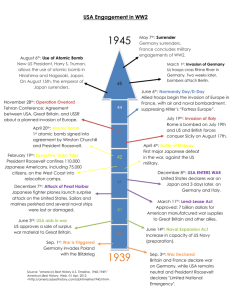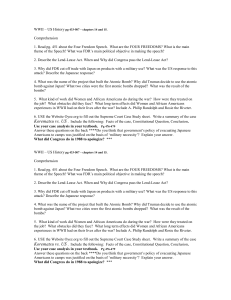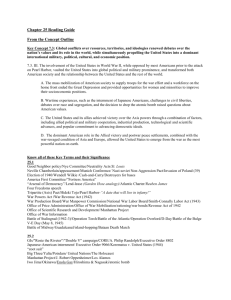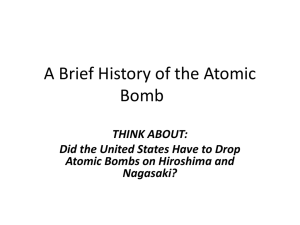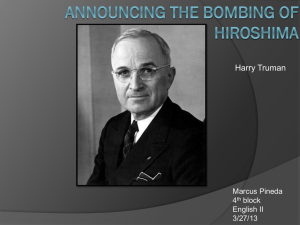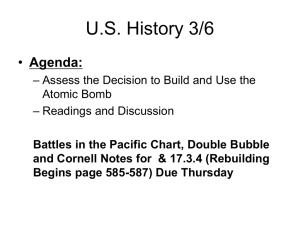Atomic Bomb - Marion County Public Schools
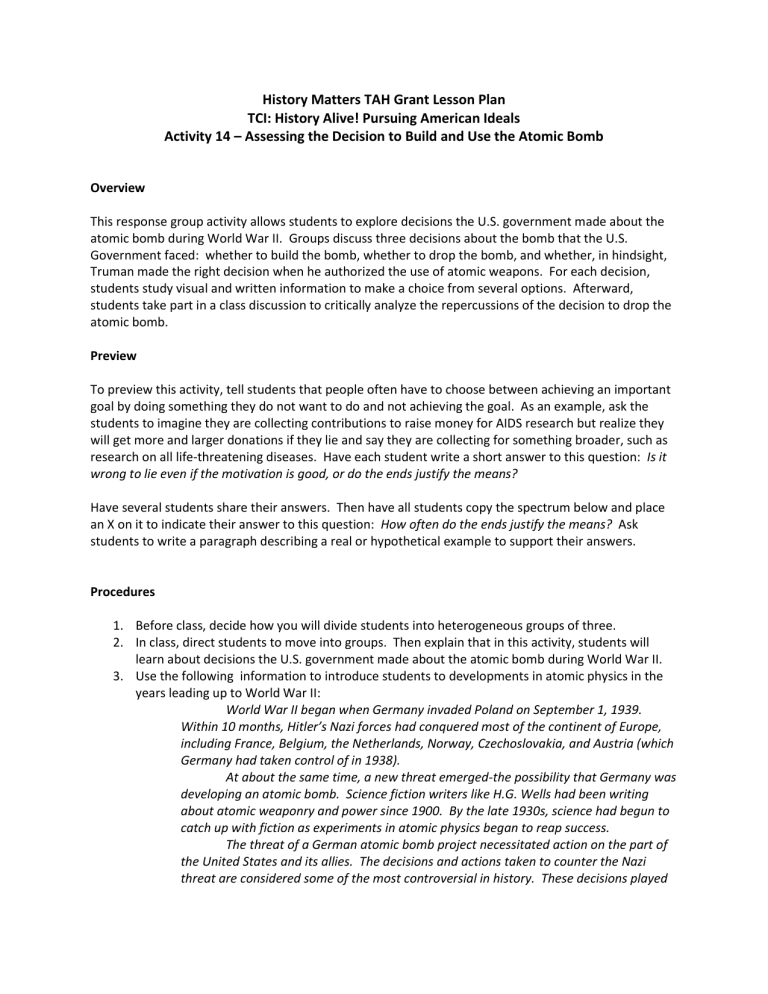
History Matters TAH Grant Lesson Plan
TCI: History Alive! Pursuing American Ideals
Activity 14 – Assessing the Decision to Build and Use the Atomic Bomb
Overview
This response group activity allows students to explore decisions the U.S. government made about the atomic bomb during World War II. Groups discuss three decisions about the bomb that the U.S.
Government faced: whether to build the bomb, whether to drop the bomb, and whether, in hindsight,
Truman made the right decision when he authorized the use of atomic weapons. For each decision, students study visual and written information to make a choice from several options. Afterward, students take part in a class discussion to critically analyze the repercussions of the decision to drop the atomic bomb.
Preview
To preview this activity, tell students that people often have to choose between achieving an important goal by doing something they do not want to do and not achieving the goal. As an example, ask the students to imagine they are collecting contributions to raise money for AIDS research but realize they will get more and larger donations if they lie and say they are collecting for something broader, such as research on all life-threatening diseases. Have each student write a short answer to this question: Is it wrong to lie even if the motivation is good, or do the ends justify the means?
Have several students share their answers. Then have all students copy the spectrum below and place an X on it to indicate their answer to this question: How often do the ends justify the means? Ask students to write a paragraph describing a real or hypothetical example to support their answers.
Procedures
1.
Before class, decide how you will divide students into heterogeneous groups of three.
2.
In class, direct students to move into groups. Then explain that in this activity, students will learn about decisions the U.S. government made about the atomic bomb during World War II.
3.
Use the following information to introduce students to developments in atomic physics in the years leading up to World War II:
World War II began when Germany invaded Poland on September 1, 1939.
Within 10 months, Hitler’s Nazi forces had conquered most of the continent of Europe, including France, Belgium, the Netherlands, Norway, Czechoslovakia, and Austria (which
Germany had taken control of in 1938).
At about the same time, a new threat emerged-the possibility that Germany was developing an atomic bomb. Science fiction writers like H.G. Wells had been writing about atomic weaponry and power since 1900. By the late 1930s, science had begun to catch up with fiction as experiments in atomic physics began to reap success.
The threat of a German atomic bomb project necessitated action on the part of the United States and its allies. The decisions and actions taken to counter the Nazi threat are considered some of the most controversial in history. These decisions played
an important role in the outcome of World War II and changed the course of world
history.
4.
Pass out Student Handout 14A. Have students read the information about Decision A on the handout. Answer any questions they may have.
5.
Once students understand the information about Decision A, have them read Critical Thinking
Question A. Encourage them to use the information on the handout to discuss the options listed. Give students adequate time – about 5 to 7 minutes – to discuss the question and record their answer on the handout.
6.
When groups have finished recording their answers, appoint a Presenter for each group. Ask
Presenters to share their group’s answer with the class. Encourage them to point out details or information on Student Handout 14A that helps explain their group’s choice. Then use the
Teacher’s Guide to reveal the decision the U.S. Government actually made.
7.
Repeat this process for the two remaining decisions. Rotate who takes on the role of Presenter for each decision.
Wrap Up
After students have discussed all three decisions, hold a class discussion about the decision to drop the atomic bomb. Focus on the following questions:
Was the decision to drop the bomb a military necessity? If not, was it justifiable for a reason besides military necessity?
Why do you think atomic weapons have not been used since World War II? What is the likelihood that they will be used in the future?
Student Response Wrap Up
Have students draw heads and facial reflecting each of the following people’s reaction to the use of the atomic bomb on Hiroshima and Nagasaki:
a U.S. soldier preparing to invade Japan
a Japanese civilian
a scientist who helped create the bomb
Josef Stalin
the student
Have student s write a thought bubble above each head that explains the reaction.
Teacher’s Guide
Decision A: Whether to Build an Atomic Bomb
In 1939, Roosevelt decides to support research aimed at creating an atomic bomb. Scientists’ progress was slow at first. However, in the spring of 1940, British scientists reported finding a process by which one could realistically develop an atomic bomb. Their announcement convinced Roosevelt and his advisor to commit fully to the development of the new weapon.
The Manhattan Project – the code name for the U.S. project to build an atomic bomb – involved the efforts of about 125,000 Americans, most of whom did not know exactly what they were working on due to the strict secrecy surrounding the project. The government set up large facilities in Hanford,
Washington, Oak Ridge, Tennesse, and Los Alamos, New Mexico, and invested more than $2 billion in the Manhattan Project. For almost three years, the largest team of scientists the world had ever known worked feverishly to produce an atomic bomb.
Both Enrico Fermi and Niels Bohr – two foreign born scientists who had moved to the United
States – played an important role in the ultimate success of the project. Although no formal decisions were made, both Roosevelt and British prime minister Winston Churchill assumed that any atomic weapon the scientists developed would be used to hasten the end of the war.
On July 16, 1945, scientists tested the”gadget” in a desert near Alamogordo, New Mexico.
Before dawn, they set off the first atomic bomb in history. The explosion first emitted a flash of bright light, a heat wave, and a fast-moving fireball; then a mushroom-shaped cloud rose eight miles into the desert sky. The sound of the explosion was so strong that people heard it 100 miles away, and the force of it shattered windows 125 miles away. The blast left a shallow but 1,200-foot-wide crater in the earth.
In short, the test was a success.
Decision B: Whether to drop an Atomic Bomb
On August 6, 1945, and American B-29 plane called Enola Gay dropped an atomic bomb on
Hiroshima, a medium-size Japanese city. The five-ton weapon, nicknamed, “Little Boy”, exploded with tremendous force 1,900 feet above the city.
Looking down from the plane, American airmen viewed a scene of destruction and death. One of the pilots later recalled, “As the bomb fell over Hiroshima and exploded, we saw an entire city disappear. I wrote in my log the words: ‘My God, what have we done?’” The blast instantly killed at least 70,000 people; thousands more died as a result of injuries.
On August 9, the United States dropped a second atomic bomb, flattening the central part of the city of Nagasaki and resulting in at least 60,000 more deaths. On the same day, Soviet forces crossed into Manchuria and pushed the Japanese army back. Japan surrendered five days later. The terms of the surrender allowed the emperor to remain as a symbolic figurehead of the Japanese government.
The effects of these atomic bombs on Hiroshima and Nagasaki were truly horrific. The temperature at the center of the blasts reached over 100 million degrees Fahrenheit. People located at the centers were instantly vaporized. People farther from the centers received deadly burns.
One survivor described the experience this way: “The appearance of the pole was….well, they all had skin blackened by burns…They had no hair because their hair was burned, and at a glance you couldn’t tell whether you were looking at them from in front or in back…Their skin-not only on the hands, but on their faces and bodies too-hung down.” Another young man described what he saw:
“Everything I saw made a deep impression-a park nearby covered with dead bodies waiting to be cremated…very badly injured people evacuated in my direction…The most impressive thing I saw was
some girls, very young girls, not only with their clothes torn off but with their skin peeled off as well…My immediate thought was that this was like the hell I had always read about.”
Weeks and even months later, people died from radiation poisoning. The victims lost their hair, vomited, and grew increasingly weak until they died. The bombing was indiscriminate-school children, the elderly in hospital beds, mothers and babies, and even some U.S. prisoners of war being held in
Hiroshima were all killed in the blasts.
Truman was returning from the Potsdam conference aboard the battleship Augusta when he received the news of the destruction at Hiroshima. He exclaimed, “This is the greatest thing in history!”
When the press raised the moral implications of the bombings, Truman defended his decision, saying,
“We have used it against those who attacked without warning at Pearl Harbor…against those who have abandoned the pretense of obeying international laws of warfare. We have used it to shorten the agony of war, in order to save the lives of thousands and thousands of young Americans.”
Decision C: Whether Truman Made the Right Decision
Historians and members of the public continue to debate Truman’s decision to drop the atomic bomb. Truman himself defended the decision until his death. Secretary of War Henry Stimson and the general in charge of the Manhattan Project, Leslie Groves, agreed. However, many of the scientists who worked on the development of the bomb had misgivings. After the successful test of the bomb at
Alamogordo, New Mexico, J.Robert Oppenheimer-the scientist in charge of the Manhattan Projectfamously quoted the Hindu epic, the Bhagavad Gita: “I am become death, the destroyer of worlds.”
After World War II, Oppenheimer became active in the failed effort to place atomic weapons research and facilities under international control. Albert Einstein, who seemed to have started it all with his letter to Roosevelt, regretted having sent the correspondence. That Albert Einstein-a great pacifist-would provide the impetus for the development of atomic weapons is one of history’s greatest ironies.
By 1990, the nuclear arsenals of the United States and the Soviet Union each included tens of thousands of weapons. By 2006, at least seven countries possessed nuclear capabilities, and other were working to develop them. However, no nuclear weapons have been used to inflict large-scale damage since World War II.
In recent years, the continued threat of the destructive use of nuclear arms has led many nations to focus on preventing any additional countries from developing nuclear weapons and significantly reducing the world’s nuclear arsenal. Such developments have further fueled the debate over the initial use of an atomic bomb. Some feel that that action was clearly ethically wrong. Others feel that the presence of nuclear weapons is the key to preventing another world war.
Student Handouts
Student Handout 14A
Decision A: Whether to Build and Atomic Bomb
In August 1939, Albert Einstein, a brilliant and well-known physicist, sent President Franklin D. Roosevelt a letter. In it, Einstein explained recent scientific developments that might mean an atomic bomb could be created. He went on to urge Roosevelt to investigate that possibility. He also suggested that
Germany might already be building an atomic bomb. The following is an excerpt from Einstein’s letter:
“In the course of the Last four months it has been made probable-through the work of
Joliet in France as well as Fermi and Szilard in America-that it may be possible to set up a nuclear chain reaction in a large mass of uranium (one of the materials essential to the construction of an atomic bomb), by which vast amounts of power and large quantities of new radium-like elements would be generated. Now it appears almost certain that this could be achieved in the immediate future.
“This new phenomenon would also lead to the construction of bombs, and it is conceivable-though much less certain-that extremely powerful bombs of a new type may thus be constructed. A single bomb of this type, carried by boat and exploded in a port, might very well destroy the whole port together with some of the surrounding territory. However, such bombs might very well prove to be too heavy for transportation by air.
“I understand that Germany has actually stopped the sale of uranium from the
Czechoslovakian mines which she has taken over. That she should have taken such early action might perhaps be understood on the ground that the son of the German Under-Secretary of
State, von Weizacker, is attached to the Kaiser-Wilhelm-Institut in Berlin where some of the
American work on uranium is now being repeated.”
When Einstein wrote this letter to Roosevelt, the United States had not yet entered into war with Germany. However, the president took immediate interest in the scientific development Einstein described. The bomb would not only be the most powerful weapon on earth, it would transform warfare by making it possible to kill more people with much less effort.
In the 18 months after Einstein sent his letter, the Roosevelt administration debated what action to take to counter the German threat. Some officials wondered how serious the threat really was. In addition, not all scientists agreed with Einstein, and some wondered whether the bomb could be developed so quickly.
Critical Thinking Question A
You are an advisor to President Roosevelt. Which of the following do you advise the president to do? Be prepared to defend your answer. a.
Ignore scientific developments and do not build and atomic bomb; concentrate U.S. efforts on building conventional weapons, such as faster planes and more powerful tanks. b.
Vigorously pursue the construction of an atomic bomb because the United States is in a race against Germany. c.
Postpone the development of an atomic bomb and send spies into Germany to determine the accuracy of Einstein’s letter. d.
Do no develop and atomic bomb. Instead, monitor the construction of new German weapons facilities and then send American bombers to destroy them. e.
Denounce the development of an atomic bomb as being immoral. Only evil could come from the development of such a destructive weapon.
Student Handout 14A
Decision B: Whether to Drop an Atomic Bomb
Vice President Harry S. Truman took over the presidency after Roosevelt unexpectedly died in April
1945. Three months later, while he was attending the Allied conference in Potsdam, Germany, Truman received a telegram stating that testing of the atomic bomb had been successful. By this time in the war, the Allies had utterly defeated Germany. However, Japan had vowed to fight on, despite the Allies’ demand at Potsdam of an unconditional surrender.
The Japanese felt that an unconditional surrender would jeopardize the position of their emperor, who they considered divine. In addition, they viewed surrender as dishonorable. They therefore fought with intense resistance. Believing it was more honorable to commit suicide than to surrender to enemy forces; Japanese kamikaze pilots strapped themselves into planes loaded with explosives and crashed them into American naval vessels. They managed to destroy 34 ships and damage hundreds of others.
Despite these desperate attacks, by July 1945 the Japanese were nearly defeated. Three factors worked against them. First, Allied bombing runs over Japan had killed tens of thousands of civilians and military personnel. Second, an Allied naval blockade made it impossible for Japan to import the goods necessary to continue fighting. It also prevented more than 1 million Japanese troops stationed in China from returning to their homeland. Third, the massive Soviet Red Army was poised to enter the war and assist the United States.
The United States had hoped to end the Pacific War by invading Japan. However, given the determination of the Japanese, President Truman worried that such an invasion would cost thousands of American lives. In light of this fear, some of his advisors recommended ending the war quickly by dropping an atomic bomb without warning on a large Japanese city.
The undersecretary of the Navy, Ralph Bard, disagreed. He told Truman that dropping the bomb without a specific warning would jeopardize “the position of the United States as a great humanitarian nation.” A group of Manhattan Project scientists suggested an alternate plan-that the United States drop the bomb in a remote, unpopulated location to show the bomb’s power and convince Japan to surrender.
Critical Thinking Question B
You are a close advisor to President Truman. Which of the following do you advise the president to do?
Be prepared to defend your answer. a.
Without warning, drop an atomic bomb on a Japanese city as soon as possible. b.
Drop an atomic bomb on an unpopulated area to demonstrate its destructive capabilities. c.
Warn the Japanese that the United States possesses atomic weapons and is willing to use them if the Japanese don’t surrender by a specific time. If they don’t surrender, then drop an atomic bomb. d.
Reject the use of atomic weapons and continue the naval blockade and conventional bombing. If the measures do not produce a Japanese surrender, then invade Japan. e.
Reject the use of atomic weapons and negotiate an end to World War II, allowing the
Japanese to surrender and their emperor to become part of the post-war government.
Student Handout 14A
Decision C: Whether Truman Made the Right Decision
Immediately after the Unites States dropped the atomic bombs on Japan, the majority of Americans felt that the right decision had been made. Surveys conducted by Fortune magazine in the fall of 1945 revealed that more than 50 percent of Americans believed the United States “should have used the two bombs on cities just as we did.” Another 22.7 percent felt the United States “should have quickly used many more (bombs) before Japan had the chance to surrender.”
Many U.S. soldiers supported Truman’s decision as well. One young soldier stated, “When the bombs were dropped and news began to circulate that (the invasion of Japan) would not, after all, take place, that we would not be obliged to run up the beaches near Tokyo assault-firing while being mortared and shelled…we cried with relief and joy. We were going to live. We were going to grow up to adulthood after all.”
Many officials in the tip ranks of the military and the government supported Truman’s decision to drop the bombs. However, others expressed doubts. Admiral William D. Leahy stated, “It is my opinion that the use of this barbarous weapon at Hiroshima and Nagasaki was of no material assistance in our war against Japan. The Japanese were already defeated and ready to surrender because of the effective sea blockade and the successful bombing with conventional weapons…My own feeling was that in being the first to use (the atomic bomb), we had adopted and ethical standard common to the barbarians of the Dark Ages.”
Dwight D. Eisenhower, a general with enormous prestige who would become the nest president, maintained the reaction he had had to the first testing of the atomic bomb. At that time, he had expressed the hope that the United States would never have to use such a weapon. Eisenhower continued to dislike seeing the country, as he put it, “initiate the use of anything (so) horrible and destructive.”
Some historians have severely criticized Truman’s decision, arguing that in August 1945 the
Japanese were already defeated. They believe that the atomic bombs were used primarily as a warning to the Soviet Union. Although the two nations were allies during World War II, the Unites States and the
Soviet Union held very different visions of the postwar world. The Soviets wanted to maintain control over Eastern Europe. The United States, on the other hand, wanted the Soviets to allow Eastern
European countries to become independent.
Historians critical of Truman’s decision argue that his main reason for authorizing the use of the atomic bombs was to scare the Soviets out of Eastern Europe and away from Asia. These historians believe that, in essence, the United States sacrificed the citizens of Hiroshima and Nagasaki in a highstakes poker game between the two superpowers. Other historians counter that it was the military pressures Truman faced at the close of World War II that played the most important role in his decision.
Critical Thinking Question C
Truman’s decision to use the atomic weapons against Japan is one of the most controversial choices made in history. In retrospect, do you think that Truman made the right decision when he authorized the use of atomic weapons? Be prepared to defend your answer. a.
Truman did not make the right decision when he authorized the use of atomic weapons. b.
Truman made the right decision when he authorized the use of atomic weapons.
Sunshine State Standards
» SS.912.A.1.2: Utilize a variety of primary and secondary sources to identify author, historical significance, audience, and authenticity to understand a historical period.
» SS.912.A.6.6: Analyze the use of atomic weapons during World War II and the aftermath of the bombings.
» SS.912.A.6.11: Examine the controversy surrounding the proliferation of nuclear technology in the
United States and the world.
Evaluation – What worked / didn’t work
I altered this History Alive! Lesson a little. Sometimes my regular American History classes do not work the best in groups. I made color copies (easier to pick up and keep separated) of each student handout and we did it as a class. They followed along as I read the handout and then I gave them several minutes to answer the critical thinking questions. They actually loved speaking out and defending their choice. I would definitely do this lesson again. It really made my students think and they enjoyed participating as a whole group project.
The History Alive! Lesson comes with transparencies that correspond to each student handout. The lesson can be done without these transparencies; but they are good for the students to see and evoke a little bit more of reality and emotion. I have attached pictures and links found on the internet that are similar and would be appropriate to correspond with each handout.
Pictures and Picture Links
Picture for Decision A
Albert Einstein and J. Robert Oppenheimer http://images.google.com/imgres?imgurl=http://upload.wikimedia.org/wikipedia/commons/a/a2/Einst ein_oppenheimer.jpg&imgrefurl=http://askville.amazon.com/man-errors-ten-yearscorrect/AnswerViewer.do%3FrequestId%3D9027780&usg=__KwLp4gWcCPWzcIDiULkdIZ1Vujc=&h=342
&w=400&sz=30&hl=en&start=164&tbnid=u7RCCW2bEICFpM:&tbnh=106&tbnw=124&prev=/images%3
Fq%3Dalbert%2Beinstein%2Banswering%2Bquestions%26gbv%3D2%26ndsp%3D20%26hl%3Den%26saf e%3Dactive%26sa%3DN%26start%3D160
Picture for Decision B
Harry S. Truman being sworn in as president after Franklin D. Roosevelt’s death on April 12, 1945. http://images.google.com/imgres?imgurl=http://frysingerreunion.org/us/us238.jpg&imgrefurl=http://w ww.galenfrysinger.com/missouri_independence.htm&usg=__Bb6uFOF3QaHe-
Qveg3ejRPcV4R0=&h=541&w=720&sz=126&hl=en&start=14&tbnid=umRUcDWsLRz3pM:&tbnh=105&tb nw=140&prev=/images%3Fq%3DHarry%2BTruman%2Bbeing%2Bsworn%2Bin%2Bas%2Bpresident%26g bv%3D2%26ndsp%3D20%26hl%3Den%26safe%3Dactive
Pictures for Decision C
A Japanese atomic bomb victim with the design of the kimono she had been wearing at the time of the attack showing on her back. http://images.google.com/imgres?imgurl=http://www.b-29s-overkorea.com/WasItNecToDropTheBomb/images/Victim-of-Atomic-Bomb.jpg&imgrefurl=http://www.b-
29s-overkorea.com/WasItNecToDropTheBomb/WasItNecessary9.html&usg=__mnC5jrqTMYaZZTOw9_q-
NtU4yJA=&h=455&w=600&sz=58&hl=en&start=5&tbnid=f9vrj7bIrUKO3M:&tbnh=102&tbnw=135&prev
=/images%3Fq%3Djapanese%2Batomic%2Bbomb%2Bvictim%26gbv%3D2%26ndsp%3D20%26hl%3Den%
26safe%3Dactive
Aerial views of Nagasaki before and after the atomic bomb was dropped just after 11:00 a.m. on August
9, 1945. http://www.gwu.edu/~nsarchiv/NSAEBB/NSAEBB162/nagasaki-2.jpg
http://images.google.com/imgres?imgurl=http://www.gwu.edu/~nsarchiv/NSAEBB/NSAEBB162/nagasa ki-
2.jpg&imgrefurl=http://www.gwu.edu/~nsarchiv/NSAEBB/NSAEBB162/index.htm&usg=__zSDquGjbe8r5
SrrSRBYxe8hPUNA=&h=722&w=570&sz=529&hl=en&start=12&tbnid=5DrXaE1Q_5qAmM:&tbnh=140&t bnw=111&prev=/images%3Fq%3Dnagasaki%2Bbefore%2Bbomb%2Bwas%2Bdropped%26gbv%3D2%26 ndsp%3D20%26hl%3Den%26safe%3Dactive

